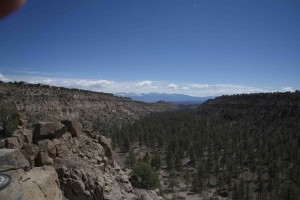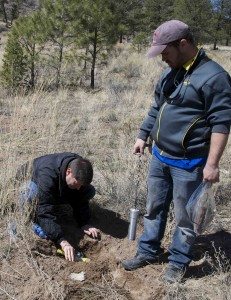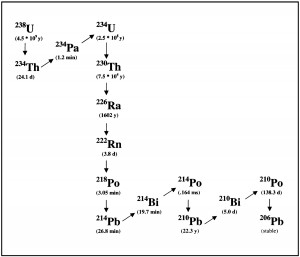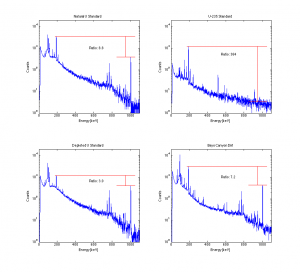In April, 2014 four friends (Brian, Dan, Jim, & Tim P) and myself hiked into Bayo Canyon of Los Alamos NM in search of historical radiological treasure. Bayo Canyon was the site of the RaLa (or RadioLanthanum) experiments that were conducted from 1944 to 1962 during which over 250 compression explosions were detonated. These experiments studied the compression of dense metal spherical shells in support of nuclear weapons development. Typically dense metals such as cadmium and copper were used, however, depleted uranium has been reported to have been employed as well.
Bayo Canyon has undergone extensive radiological remediation, however, despite the undoubted best efforts of the laboratory, radiological treasures continue to percolate to the surface with annual weather cycles. Many scraps of metal, plastics, coaxial cables, can still be found today. Some with persistent radiological contamination.
Most of the team surveyed with G-M detectors, primarily sensitive to charged particle radiations. However, Tim Ponter surveyed with a 2×2 NaI(Tl) detector, sensitive only to gamma rays. He located an area of general high background without a definitive point of origin. Considering that the source must be buried substantially below the ground’s surface, Jim and Dan began digging with improvised tools, occasionally stopping to measure the progress. It soon became clear that the source of radiation was the soil itself with a homogenous distribution of contamination. I guzzled my only bottle of water to offer a sample container, which Jim filled half-way with the most active soil.
Back home in the lab, I transferred the soil sample to a 150 ml Nalgene bottle, and performed a 4-hour background subtracted HPGe gamma ray spectroscopy count. The measurement surprisingly revealed a gamma ray spectrum signature closer to natural uranium than depleted uranium. To verify this, the spectra of isotopically enriched uranium 235, isotopically natural uranium, and depleted uranium standards were compared. More sophisticated analyses will compare ratios of Np239 and other decay chain products.
However, since the Pa234m (t1/2 1.2m) isotope has reached equilibrium with parent Th234 (t1/2 24 days) whose parent is U238 we can use the Pa234m 1001.3 keV gamma ray to roughly judge the Bayo Canyon soil’s uranium classification. Simply determining the U235 185 keV gamma to the U238’s descendant’s Pa234m 1001.3 keV gamma ratio of our three standards, we can make a statement about he soils enrichment, or lack thereof. The natural and depleted uranium standards were prepared comparable sized containers (though not exact). The U235 standard utilized a defunct fission chamber.
The ratio of 185 keV/1001.3 keV for the natural uranium standard was 8.8; the ratio for the U235 standard was 364; the ratio for the depleted uranium standard was 3.0. The ratio of the Bayo Canyon soil was measured as 7.2. While not exactly the same ratio of the natural uranium standard, the soil sample’s ratio came closest to matching it, coming to the conclusion, this contaminated soil find was most likely from an experiment involving a natural uranium spherical shell.



